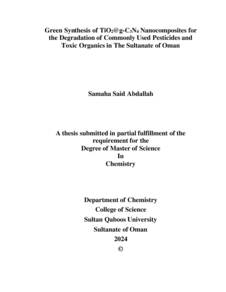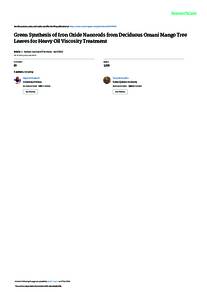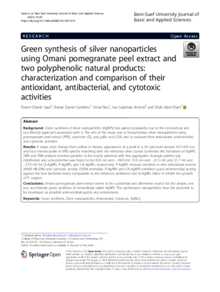وثيقة
Green synthesis of TiO2@g-C3N4 nanocomposites for the degradation of commonly used pesticides and toxic organics in the Sultanate of Oman.
المصدر
Master's thesis
عناوين أخرى
التخليق الاخضر للمركبات النانوية 4N3C-g@2TiO لتحلل المبيدات الحشرية شائعة الاستخدام والمواد العضوية السامة في سلطنة عمان
الدولة
Oman
مكان النشر
Muscat
الناشر
Sultan Qaboos University
ميلادي
2024
اللغة
الأنجليزية
الموضوع
نوع الرسالة الجامعية
Master's thesis
الملخص الإنجليزي
Natural waters nowadays are polluted by various hazardous chemical substances from
many industrial activities. The harmful effects of chemicals on the earth’s ecosystems are
a cause for serious concern. Several of these chemicals, such as azo dyes, herbicides, and
pesticides, are present in rivers and lakes and are in part suspected of being endocrinedisrupting chemicals (EDCs). Although it is still being discussed whether such chemicals
influence human beings or not, it is necessary to develop efficient techniques for the
elimination and decomposition of those EDCs from water and wastewater as soon as
possible. To address the environmental challenges caused by toxic organics such as
Bisphenol A photocatalytic degradation is a promising option. The present study
investigates the green synthesis of TiO2@g-C3N4 nanocomposites and their application in
the photocatalytic degradation of toxic organics including Bisphenol A and an insecticide
Malathion. In this study leaf extract from the Ziziphus jujube plant was utilized as a green
template making the synthesis environmentally friendly, utilizing renewable resources,
and employing facile and cost-effective methods for the preparation of TiO2. The prepared
Titanium dioxide (TiO2) and graphitic carbon nitride (g-C3N4) have been used in various
percentages to prepare its composite materials and applied for photocatalytic studies. The
nanocomposites were characterized using multiple advanced analytical techniques
including UV-Vis DRS, FESEM, EDXS, FTIR, XPS, and XRD to analyze the structural
and morphological properties. The photocatalytic activity of the synthesized
nanocomposites was evaluated through the degradation of toxic organic pollutants
including Bisphenol A and Malathion under UV light irradiation. The results indicated
71% degradation of Bisphenol A and 74% degradation of Malathion, with the 50%
TiO2@g-C3N4 nanocomposites exhibiting the highest photocatalytic degradation towards
Bisphenol A and 20% TiO2@g-C3N4 towards Malathion, whereas, both showcased higher
performance than the individual TiO2 and g-C3N4 nanostructured materials.
الملخص العربي
تتلوث المياه الطبيعية في الوقت الحاضر بمجموعة متنوعة من المواد الكيميائية الخطرة المستمدة من العديد من الانشطة الصناعية. إن الاثار الضارة للمواد الكيميائية على النظم البيئية لألرض هي مصدر قلق شديد للإنسان. حيث أن العديد من هذه المواد الكيميائية، مثل أصباغ الازو، ومبيدات الاعشاب، ومبيدات الافات، موجودة بالفعل في الانهار والبحيرات، ويُشتبه جزئيًا في كونها مواد كيميائية تسبب اختالل الغدد الصماء )EDCs). وعلى الرغم من أن الابحاث لا زالت جارية في ما إذا كانت هذه المواد الكيميائية لها تأثير على البشر أم ال، فمن الضروري تطوير تقنيات فعالة للتخلص من تلك المواد الكيميائية وتفكيكها من المياه ومياه الصرف الصحي في أسرع وقت ممكن. لمواجهة التحديات البيئية الناجمة عن المواد العضوية السامة مثل البيسفينول أ، يعد التحلل الضوئي خيا ًرا واعدًا. هذه الدراسة تبحث في التوليف الاخضر للمركبات النانوية 4N3C-g@2TiO وتطبيقاتها في التحلل الضوئي للمواد العضوية السامة بما في ذلك A Bisphenol ومبيد الحشرات Malathion. في هذه الدراسة تم استخدام مستخلص أوراق نبات jujube ا للبيئة، وذلك باستخدام موارد متجددة وطرق سهلة ومجدية Ziziphus كقالب أخضر مما يجعل التركيب صديقً اقتصاديا لتحضير 2TiO. تم استخدام ثاني أكسيد التيتانيوم ) 2TiO )ونيتريد الكربون الجرافيتي )4N3C-g ) المحضرين بنسب مختلفة لتحضير المواد المركبة وتطبيقها في دراسات التحفيز الضوئي. ثم تم تشخيص المركبات النانوية باستخدام العديد من التقنيات التحليلية المتقدمة بما في ذلك DRS Vis-UV و FESEM و FTIR ,EDXS وXPS وXRD لتحليل الخصائص الهيكلية والتشكلية. ومن ثم تم تقييم نشاط التحفيز الضوئي للمركبات النانوية المصنعة من خالل تحلل الملوثات العضوية السامة بما في ذلك البيسفينول أ والمالثيون تحت أشعة الضوء فوق البنفسجية. عالوة على ذلك، أشارت المركبات النانوية إلى نشاط تحفيز ضوئي ممتاز و مستقر وقابل إلعادة التدوير مما يجعلها مناسبة لمعالجة المياه ومياه الصرف الصحي والمعالجة البيئية. أشارت النتائج إلى تحلل %71 A Bisphenol و%74 تحلل للمالثيون، حيث أظهرت المركبات النانوية%50 4N3C-g@2TiO أعلى تحلل ًء تحفيزي ضوئي تجاه A Bisphenol و%20 4N3C-g@2TiO تجاه Malathion، في حين أظهر كلاهما أدا أفضل من المواد الفردية ذات البنية النانوية 2TiO و4N3C-g.
قالب العنصر
الرسائل والأطروحات الجامعية



